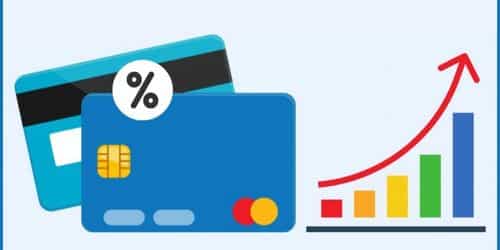Since 2010, the average interest rate on new credit card offers has risen by nearly two percentage points. According to WalletHub’s Credit Card Landscape Report, the average credit card interest rate for new offers is 21.96% and 19.07% for existing accounts. Here, we’ll discuss the best interest rate you should have on your credit card, depending on the category.
Average Credit Card Interest Rate By Category
Credit Card Interest Rates As A Function Of Credit Score
Higher credit scores may qualify you for lower interest rates on credit cards, loans, and other types of financing. As a result, having a good credit score can help you save money.
In contrast, low credit scores indicate a higher risk for the credit card company. As a cardholder, this status usually translates into higher APRs. It is not uncommon to come across credit cards with APRs as high as 25% to 30%.
Credit card interest rates can vary from one company to the next, as well as between individual cardholders. The type of credit card you open can also affect your APR, with rewards credit cards typically offering higher interest rates than other credit card products.
Interest Rates on Other Credit Cards
The above-mentioned average rates are known as regular APRs. Under normal circumstances, they apply to purchases and balance transfers. However, there are several other types of interest rates to be aware of.
The following are the other typical credit card interest rates:
Purchase Introductory APR of 0% for 12 months – This promotional rate, which is usually 0%, is only available for a limited time before the regular APR kicks in.
Balance Transfer Intro APR: 0% for 13 months – Usually 0% and sometimes offered for the same period of time as the purchase intro APR, this promotional rate applies to balance transfers from another credit card or loan.
Penalty APR: 26.67% – This interest rate will be applied only if you fail to make your minimum payments.
Cash Advance APR: 23.59% – You can use your credit card to withdraw money from an ATM just like a debit card. However, interest will begin to accrue immediately, and you will be charged a significant fee.
How Your Credit Card Interest Rate Can Affect You
When it comes to interest rates, it’s always best to get the lowest possible figure. On paper, the difference between a 15% APR and a 20% APR may not appear to be significant. However, if you carry a balance on your credit card, a lower interest rate could save you thousands of dollars.
Your credit card interest rate has an impact on how long it takes you to pay off your debt. A lower APR can help you get out of debt faster and easier.
Of course, paying off your credit card balance in full each month is the best way to manage credit cards. If you can develop this habit and avoid credit card debt in the first place, your account’s APR should have no effect on your budget. In fact, if you pay off your entire statement balance each month, you can avoid paying credit card interest entirely.
How to Lower Your Credit Card Interest Rate
If you’re attempting to pay off credit card debt, obtaining a lower interest rate may help you save money and get out of debt faster. The following are some strategies you can try to lower your credit card APR.
#1. Balance Transfer
You may be able to open a new credit card in order to take advantage of a low or 0% APR balance transfer offer. Low introductory balance transfer credit card interest rates do not last forever (typically 12 to 18 months). However, if you can afford to attack your debt aggressively while the introductory APR is in effect, you may be able to significantly reduce or eliminate your credit card debt.
A balance transfer calculator can help you calculate your potential savings by taking into account balance transfer fees, introductory rates, and other factors. It’s also a good idea to compare multiple balance transfer credit card offers to ensure you get the best deal and fit for your needs. Remember that you’ll usually need good to excellent credit to qualify.
#2. Loan Consolidation
Another option for lowering your interest rate on existing credit card debt is to pay it off with a debt consolidation loan. Depending on your credit score, debt-to-income (DTI) ratio, and other factors, you may be able to obtain a new personal loan with a lower interest rate than the one you’re currently paying on your credit card accounts.
A low-interest debt consolidation loan could save you money while also speeding up the debt-reduction process. Furthermore, by consolidating your revolving credit card debt with an installment loan, you could lower your credit card utilization rate while potentially improving your credit score.
#3. Inquire with Your Credit Card Company
Your credit card interest rate is not set in stone. You can ask your credit card company if they are willing to lower your interest rate, and in some cases, you may be successful.
Inform the card issuer if you’ve seen credit card offers with lower interest rates that you’re interested in. A history of on-time payments on your account, as well as a good credit score, may also work in your favor when making your request.
#4. Examine your credit reports.
Knowing where you stand is essential when attempting to improve your credit. The good news is that checking your three major credit bureaus (Equifax, TransUnion, and Experian) credit reports is simple and free. Once every 12 months, go to AnnualCreditReport.com to get a free credit report from each bureau. You can get free weekly access to your credit reports through the same website during the pandemic.
#5. Take note of any negative credit information.
Once you have your reports, go through them from beginning to end. Make a note of any negative information that you discover that may be affecting your credit scores. You may be powerless to address these issues until they fade from your credit report. However, you can make an effort to avoid making the same mistakes.
#6. Resolve any credit-related issues.
While reviewing your credit reports, make a note of any credit reporting errors or signs of fraud that you discover. The Fair Credit Reporting Act (FCRA) gives you the right to dispute any incorrect information on your credit report with the appropriate credit bureau.
#7. Reduce your credit card debt.
Lowering your credit card balances, and thus your credit utilization ratio, is one of the most immediate ways to improve your credit score. Credit utilization is a significant credit score factor, accounting for 30% of your FICO Score. A low credit utilization ratio indicates that you are less of a credit risk.
#8. Demonstrate a track record of timely payments.
The most important factor in determining your FICO Score is whether you pay your credit obligations on time or late. When you avoid late payments, you can increase your chances of success with your credit score. Even the occasional delinquency on your credit report, however, can be a major setback.
#9. Consider establishing new accounts.
Opening new credit accounts may benefit you if you have a thin credit file or need to build credit for the first time. It can be difficult to qualify for certain loans or credit cards if you have no credit history. However, some options, such as secured credit cards or credit-builder loans, may work well for you as long as you pay on time every time. You could also consider requesting that a loved one add you as an authorized user on an existing credit card account.
#10. Compare prices.
Credit cards can be easily compared based on their regular and introductory interest rates, among other factors. And if you know your credit score, you’ll know what interest rate you deserve.
#11. Take advantage of 0% interest offers.
Applying for a 0% credit card before making a large purchase that will take months to repay can save you a lot of money. The same is true when transferring a high-interest balance to a 0% balance transfer credit card. You simply must devise a repayment strategy by the end of the 0% period. A credit card calculator can assist you with this.
#18. Separate your debt from your everyday spending.
Using a single credit card for everything is not a good idea. Don’t use a credit card that you can’t afford to pay off in full by the due date if you’re also carrying a balance from month to month. That’s because your everyday purchases will accrue interest alongside your outstanding balance. However, if you obtain another credit card solely for such everyday spending, interest will not be charged as long as you pay your bill in full each month.
Is 17% Interest Rate On A Credit Card Good?
If your APR is less than the national average of around 17%, you have a good interest rate. The lower the interest rate, the lower the APR. However, what is good for you will be determined by your credit history, credit score, and overall creditworthiness.
Is a 24.99 a Good Interest Rate?
A 24.99% APR is not acceptable for mortgages, student loans, or auto loans because it is significantly higher than what most borrowers should expect to pay and what most lenders will even offer. A 24.99% APR is reasonable for personal loans and credit cards, especially for people with poor credit.
Is 18% Interest Rate High for a Credit Card?
A credit card with a 20% APR is higher than the average interest rate for new credit card offers. A 20% APR means that if the cardholder keeps a balance on the card for the entire year, the balance will increase by approximately 20%.
Do Credit Cards Charge Interest If You Pay In Full?
Credit card companies charge interest unless your balance is paid in full each month. Most credit card interest rates are variable and change from time to time. Some credit cards have different interest rates for purchases and cash advances.
Do Credit Cards Charge If Not Used?
Inactivity fees were once charged by credit card companies, but the Federal Reserve prohibited this practice in 2010. Even though you will no longer be charged for inactivity, you will still be charged on a regular basis, primarily the annual fee and any interest that you accrue.
How Often Should You Use Your Credit Card?
To keep your credit card active, you should use it at least once every three months (but more often than that if you want your credit score to improve at a faster rate). When it comes to credit card inactivity, not all issuers are created equal.
In Conclusion,
Improving your credit score can help you qualify for lower credit card interest rates. But don’t be disheartened if you need to improve your credit score before you can qualify for the best deals. As long as you pay your monthly statement balance in full, you can enjoy the many benefits that credit cards have to offer without paying any interest fees—regardless of your credit card account’s current APR.
Related Articles
- FINANCE CHARGE: What Exactly Are Finance Charges? Why Are They Important?
- Best Business Credit Cards For Startups In 2023
- WHAT IS APR: How it works
- $2000 LOANS: What to Know About Getting a $2000 Loan With No Credit Check






